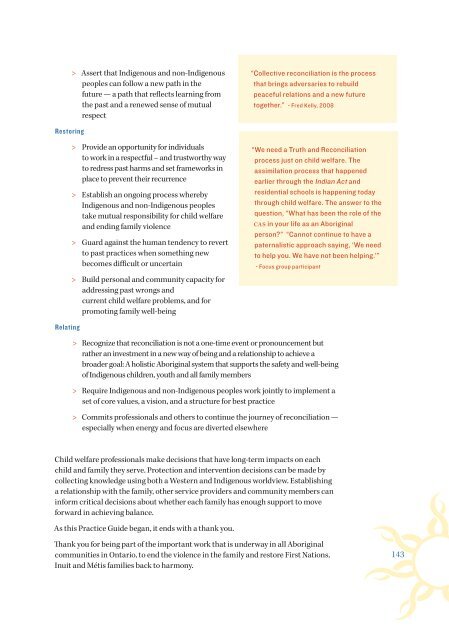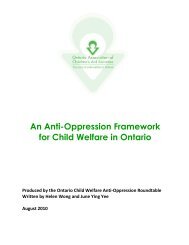English - Ontario Association of Children's Aid Societies
English - Ontario Association of Children's Aid Societies
English - Ontario Association of Children's Aid Societies
You also want an ePaper? Increase the reach of your titles
YUMPU automatically turns print PDFs into web optimized ePapers that Google loves.
Assert that Indigenous and non-Indigenous<br />
peoples can follow a new path in the<br />
future — a path that reflects learning from<br />
the past and a renewed sense <strong>of</strong> mutual<br />
respect<br />
“Collective reconciliation is the process<br />
that brings adversaries to rebuild<br />
peaceful relations and a new future<br />
together.” - Fred Kelly, 2008<br />
Restoring<br />
> > Provide an opportunity for individuals<br />
to work in a respectful – and trustworthy way<br />
to redress past harms and set frameworks in<br />
place to prevent their recurrence<br />
> > Establish an ongoing process whereby<br />
Indigenous and non-Indigenous peoples<br />
take mutual responsibility for child welfare<br />
and ending family violence<br />
> > Guard against the human tendency to revert<br />
to past practices when something new<br />
becomes difficult or uncertain<br />
> > Build personal and community capacity for<br />
addressing past wrongs and<br />
current child welfare problems, and for<br />
promoting family well-being<br />
“We need a Truth and Reconciliation<br />
process just on child welfare. The<br />
assimilation process that happened<br />
earlier through the Indian Act and<br />
residential schools is happening today<br />
through child welfare. The answer to the<br />
question, “What has been the role <strong>of</strong> the<br />
CAS in your life as an Aboriginal<br />
person” “Cannot continue to have a<br />
paternalistic approach saying, ‘We need<br />
to help you. We have not been helping.’”<br />
- Focus group participant<br />
Relating<br />
> > Recognize that reconciliation is not a one-time event or pronouncement but<br />
rather an investment in a new way <strong>of</strong> being and a relationship to achieve a<br />
broader goal: A holistic Aboriginal system that supports the safety and well-being<br />
<strong>of</strong> Indigenous children, youth and all family members<br />
> > Require Indigenous and non-Indigenous peoples work jointly to implement a<br />
set <strong>of</strong> core values, a vision, and a structure for best practice<br />
> > Commits pr<strong>of</strong>essionals and others to continue the journey <strong>of</strong> reconciliation — <br />
especially when energy and focus are diverted elsewhere<br />
Child welfare pr<strong>of</strong>essionals make decisions that have long-term impacts on each<br />
child and family they serve. Protection and intervention decisions can be made by<br />
collecting knowledge using both a Western and Indigenous worldview. Establishing<br />
a relationship with the family, other service providers and community members can<br />
inform critical decisions about whether each family has enough support to move<br />
forward in achieving balance.<br />
As this Practice Guide began, it ends with a thank you.<br />
Thank you for being part <strong>of</strong> the important work that is underway in all Aboriginal<br />
communities in <strong>Ontario</strong>, to end the violence in the family and restore First Nations,<br />
Inuit and Métis families back to harmony.<br />
143

















